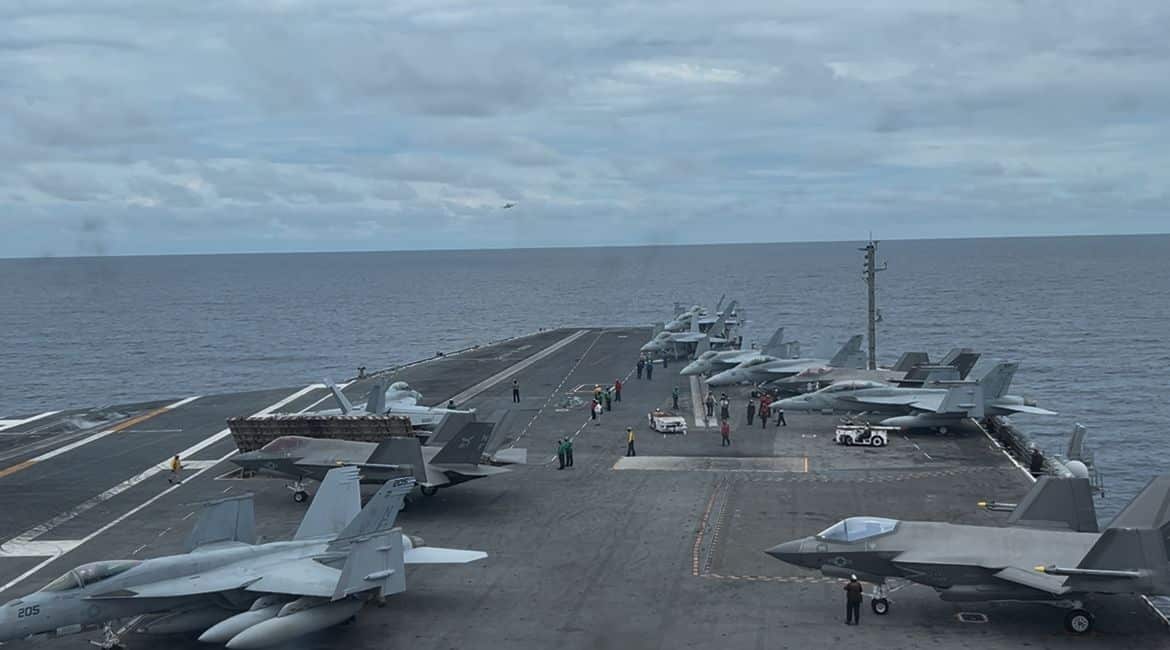US aircraft carrier holds ‘typical’ ops in West PH Sea; China’s ire seen

USS George Washington conducts flight operations on July 2, 2025 in the West Philippine Sea. — Photo by John Eric Mendoza
ABOARD USS GEORGE WASHINGTON — This United States aircraft carrier conducted its flight operations here in the West Philippine Sea on Wednesday in a show of force which an analyst said also serves as a subtle warning to China amid its continuous aggressive moves in the region.
Inquirer is among the selected media outfits to witness the activity Wednesday, a move which the USS George Washington’s commanding officer deems as routine.
“This is a typical patrol for us,” said Capt. Tim Waits, the carrier strike group’s commanding officer, in an interview with reporters. “We’re out here to do what we do in expressing those shared ideals with our partners and allies in the region and that is the free and open Indo-Pacific idea that we have.”
Aside from this aircraft carrier, an American missile submarine as well as its two amphibious warships were spotted in the region since last week, according to the report of American magazine Newsweek on Tuesday.
WATCH: American aircraft carrier USS George Washington conducts flight operations in the West Philippine Sea today. | @JEMendozaINQ pic.twitter.com/Q5YkCLcQ4S
— Inquirer (@inquirerdotnet) July 2, 2025
A senior fellow of Hawaii-based East-West center said such a deployment aims to send a signal that the US is still interested in “maintaining strategic influence” in the Indo-Pacific region to counter China.
“Essentially, it means ‘we might use this against you if you cross us,’ without needing to say so,” said Chinese foreign policy expert Denny Roy said in an interview with Inquirer on Wednesday.
READ: Lithuania’s defense chief praises PH campaign exposing China aggression
Beijing has made aggressive actions against the Filipino coast guard, navy, and fisherfolk in asserting its sovereignty claim in almost the entire South China Sea, but the historic arbitral tribunal ruling effectively dismissed this while ruling heavily in favor of Manila’s sovereign rights in the western section of its exclusive economic zone.
For security expert Chester Cabalza the presence of USS George Washington should be treated as a “balancer.”
“The American nuclear-powered aircraft carrier is a good counter-offensive measure to Chinese attempts to dominate the region,” Cabalza, president and founder of Manila-based think tank International Development and Security Cooperation, in a message to Inquirer on Tuesday.
Unsurprisingly, Roy said Beijing is expected to interpret Washington’s military activity in the region as “gunboat diplomacy” which “fails to acknowledge China’s great power status.”
“The typical Chinese response would be that military muscle flexing by the US is unhelpful (it’s different, of course, when China does it) and the US should stop raising tensions and trying to recruit regional countries to help contain China,” Roy further said.
The regional power also dipped its toes in the open Pacific for the first time with its two aircraft carriers—Liaoning and Shandong—being found operating outside the “first island chain” last May, according to Japan’s ministry of defense.
Philippines is part of the “first island chain,” which experts view as Washington’s first line of defense against Beijing’s expansion in the Pacific.
Cabalza said China’s latest move “will sow more power projections and competitions in the hegemonic rivalry of Beijing and Washington.”
But despite it being unprecedented, a US senior defense official shrugged off the dual patrol of two Chinese aircraft carriers.
Built by the Soviet Union in the 1980s and sold by Ukraine in 1998, Liaoning was commissioned in 2012, becoming the first-ever aircraft carrier of the People’s Liberation Army-Navy (PLA-N). In 2019, the PLA-N commissioned its first-ever domestically-built aircraft carrier Shandong.
The official noted that it took Liaoning 13 years while Shandong took around five and a half years to get out of the “first island chain”, which they noted is only about hundred miles away from the regional powers’ home port.
“That’s what every other carrier base nation has been able to do for decades,” the official said last month in an on background briefing with Filipino and Japanese journalists in Hawaii. “Big, fat, hairy deal.”
“If I sound a little dismissive, I am,” the official further said, further noting that 85 percent of Chinese navy’s activity is within the “first island chain.”
However, maritime expert Ray Powell said that while the Chinese navy has a lot of catching up to do, he believes that the latest activity of the two aircraft carriers is a “big deal.”
“It takes a long time to build up a carrier force, and they’re still quite early in the journey,” Powell, director of SeaLight and program head of Stanford University’s Gordian Knot Center for National Security Innovation, told Inquirer on Tuesday.
“I do think it’s a big deal and a sign of their rapidly growing naval power,” Powell said. “The official was correct that as of this moment they remain regionally focused, and they have a lot of catching up to do.”
“On the other hand, this is the region they’re focused on and they are building up quickly,” he continued. /das/cb
For comprehensive coverage, in-depth analysis, visit our special page for West Philippine Sea updates. Stay informed with articles, videos, and expert opinions.


















